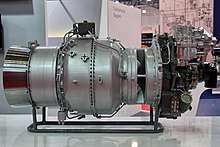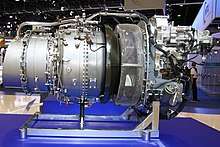Safran Ardiden
The Safran Ardiden is a 1,400–2,000 hp (1,000–1,500 kW) turboshaft designed and produced by Safran Helicopter Engines for 5–8 t (11,000–18,000 lb) single and twin-engine helicopters. Launched in 2003 as a more powerful TM 333, it first ran in 2005 and was introduced in 2007. The Ardiden 1 Shakti powers the Indian HAL Dhruv, Light Combat Helicopter and Light Utility Helicopter while the more powerful Ardiden 3 powers the Avicopter AC352 and Kamov Ka-62.
| Ardiden | |
|---|---|
 | |
| Type | Turboshaft |
| National origin | France |
| Manufacturer | Safran Helicopter Engines |
| First run | 2005[1] |
| Major applications | HAL Dhruv |
| Number built | 250 by 2018[2] |
| Unit cost | $500,000 (projected in 2002)[3] |
| Developed from | Turbomeca TM 333 |
Development
In 1961, Turbomeca granted Hindustan Aeronautics (HAL) a manufacturing license for the Artouste turboshaft engine to equip the Indian Alouette III Chetak and Alouette II Cheetah helicopters.
By September 2000, HAL had contracted with Turbomeca to develop a more powerful version of the ALH's TM 3332B2, from 747 to 800 kW (1,002 to 1,073 hp).[4] By January 2002, Turbomeca had begun developing the 1,200 hp (890 kW) Ardiden TM3332C2 for 5–6 t (11,000–13,000 lb) helicopters, launched at the Paris Air Show for the LAH as the Shakti, co-developed and assembled by HAL, as the US lifted India's 1998 nuclear tests sanctions. The TM3332B2 first two axial stages were replaced by a centrifugal compressor, and the power turbine went from one to two stages, while the two channel FADEC came from the TM3332E. Then expected to enter service in 2005, its estimated market was 1,500 engines over the first 15 years.[5]
By July 2002, Turbomeca was ready to launch the 900 kW (1,200 hp) engine development with HAL for 11% for the ALH, then renamed Dhruv. The TM333 was derated from 800 to 765 kW (1,073 to 1,026 hp) for the Dhruv, and the Ardiden 1H Shakti would be derated from 1,070 to 900 kW (1,430 to 1,210 hp). The Ardiden 1A was designed to for the Eurocopter EC155HP+, and the Ardiden 2K for the Agusta-Bell AB.139. It would slot between the 485–740 kW (650–992 hp) Arriel and the 1,240–1,565 kW (1,663–2,099 hp) Makila for 5-6 t (11,000-13,250lb) medium twins. At $500,000, it would be 40% cheaper than 900kW competitors like the Honeywell/Rolls-Royce LHTEC CTS800 and the MTU/Turbomeca/R-R MTR390. The first test run was then expected in early 2004, flight-testing by the end of the same year, certification by the end of 2005 and entry into service by 2006.[3] It was launched in February 2003 at the Aero India show with a large order from HAL, to be used in 6-6.5 t (13,200-14,300lb) helicopters. HAL was to supply one-tenth of its components.[6]
By October 2005, Turbomeca ran the first example in Tarbes, planning a July 2006 first flight. HAL has an 11% stake in development and 21% of the manufacture: the gearbox, power turbine and part of the HP compressor. The design include the single-crystal HP turbine blades and new ceramic coatings to run without cooling, for 20% of growth potential.[1]
Developed by India for 19%, the Shakti made its first test flight on the Dhruv on 16 August 2007.[7] By late 2007, HAL started fitting the Shakti for Dhruvs produced from then.
The Ardiden 3G was certified in June 2017 and by 2018, 250 Ardiden 1 were in service.[2] By September 2019, the Ardiden 1 engines had completed 200,000 flying hours, and the Ardiden 3C/3G had completed over 10,000 hours of tests.[8]
Turboprop version
By April 2019, Safran was considering a turboprop version of the Ardiden to compete with the Pratt & Whitney Canada PT6 and General Electric Catalyst, based on its Tech-TP demonstrator, part of the EU's Clean Sky 2 programme, for first ground runs in the coming months.[9] The first ground run happened on 12 June in Tarnos; the complete propulsion system include the nacelle, air intake and propeller while the accessory gearbox and propeller controller include more electric technologies.[10]
It could be used for a future European UAV, in cooperation with ZF Luftfahrttechnik for the gearbox and MT-Propeller for the propeller. The FADEC would manage both power and propeller pitch for operation up to 13,716 meters / 45,000 ft. The Tech TP compact, lightweight architecture targets a 15% lower fuel consumption over current engines.[8] On 21 July 2020, a memorandum of agreement was signed between Safran and ZF, targeting flight testing of the 1,700-2,000shp (1,260-1,490kW) Ardiden 3TP from 2022. The 11 t EuroMALE UAV, set for a 2024 first flight, is a goal as a first platform, before civil applications.[11]
Design
The Ardiden 1 offers 1,400 to 1,700 hp (1,000 to 1,300 kW) and the Ardiden 3 covers the 1,700–2,000 hp (1,300–1,500 kW) range, for 5 to 8 t (11,000 to 18,000 lb) single and twin-engine helicopters.[2]
The Ardiden has a two-stage centrifugal compressor, then a reverse flow annular combustor, a single stage axial gas generator turbine followed by a two-stage axial free turbine outputting its power to the front by a concentric shaft, and is controlled by a dual-channel digital engine electronic control unit.[12]
Variants and applications

| Variant | Certification[12][13] | Application[2] |
|---|---|---|
| Ardiden 1H | 20 December 2007 | HAL Dhruv HAL Light Combat Helicopter |
| Ardiden 1H1 | 11 March 2009 | |
| Ardiden 1U | HAL Light Utility Helicopter | |
| Ardiden 3G | 12 June 2017 | Kamov Ka-62 |
| Ardiden 3C / WZ16 | 5 April 2018 | Avicopter AC352 |
Specifications
| Variant | Ardiden 1[12] | Ardiden 3[13] |
|---|---|---|
| length | 1,250 mm (49 in) | 1,244–1,285.4 mm (48.98–50.61 in) |
| height × width | 694×519 mm (27.3×20.4 in) | 648×640–655.9 mm (25.51×25.20–25.82 in) |
| weight | 205 kg (452 lb) | 215–226.6 kg (474–500 lb) |
| compressor | 2 centrifugal stages | |
| combustor | reverse flow | |
| turbine | 1 HP stage, 2 power stages | |
| T/O power | 938–1,032 kW (1,258–1,384 hp) | 1,177–968 kW (1,578–1,298 hp) |
| power/weight | 4.58–5.03 kW/kg (2.79–3.06 hp/lb) | 5.47–4.27 kW/kg (3.33–2.60 hp/lb) |
See also
Related development
Comparable engines
- HAL HTSE-1200
- LHTEC CTS800
- MTR390
- Pratt & Whitney Canada PT6
- Safran Arrano
Related lists
References
- "Ardiden has first test run". Flightglobal. 11 Oct 2005.
- "Ardiden". Safran Helicopter Engines.
- "Turbomeca set to launch Ardiden". Flight International. 2 July 2002.
- "Turbomeca buy gives Snecma a foothold in turboshaft market". Aviation Week. Sep 4, 2000. p. 30.
- "New Turbomeca engine to power India's LAH". Aviation Week. Jan 7, 2002. p. 30.
- "Turbomeca and HAL strengthen ties". Flight International. 11 Feb 2003.
- "Dhruvs with Shakti engine and weapons make maiden flight" (Press release). HAL. 16 Aug 2007. Archived from the original on 28 September 2007.
- Alexandre Rocchi (25 Sep 2019). "Safran will design new turboprop for a European UAV". Air & Cosmos.
- Dominic Perry (29 Apr 2019). "Safran eyes turboprop variant of Ardiden 3 helicopter engine". Flightglobal.
- Dominic Perry (18 June 2019). "Safran runs Tech TP demonstrator for first time". Flightglobal.
- Dominic Perry (21 July 2020). "Safran and ZF press ahead with new military turboprop engine development". Flightglobal.
- "Type Certificate Data Sheet EA E.037 for Ardiden 1" (PDF). EASA. 1 February 2017.
- "Type certificate data sheet No. E. 103 for Ardiden 3" (PDF). EASA. 5 April 2018.
